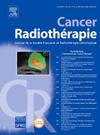Hypofractionated radiotherapy in the management of bladder cancer
IF 1.4
4区 医学
Q4 ONCOLOGY
引用次数: 0
Abstract
Purpose
Trimodal therapy, combining transurethral resection of the bladder tumour, radiotherapy, and concurrent radiosensitization, is an established bladder-preserving alternative to radical cystectomy in muscle-invasive bladder cancer. Hypofractionated radiotherapy has gained interest due to radiobiological advantages and logistical convenience, yet its efficacy and safety remain under evaluation.
Methods
A review of prospective phase II and III trials published between 2000 and 2025 was conducted in Medline using the search engine PubMed. Studies were included if they assessed hypofractionated radiotherapy (excluding stereotactic body radiotherapy) for non-metastatic muscle-invasive bladder cancer within a curative-intent using a trimodal therapy approach. Key endpoints included progression-free survival, overall survival, and toxicity.
Results
Seven prospective trials (five phase II, two phase III) were identified. The largest evidence come from the BC2001 and BCON trials, which demonstrated that a dose of 55 Gy delivered in 20 fractions was non-inferior to a dose of 64 Gy delivered in 32 fractions in terms of locoregional control and overall survival, with similar genitourinary and gastrointestinal toxicity rates. Additional studies confirmed comparable efficacy between hypofractionated and conventional fractionated radiotherapy regimens. Various concurrent systemic therapies were used, including cisplatin, 5-fluorouracil with mitomycin C, gemcitabine, and carbogen with nicotinamide, though no regimen showed clear superiority. Elective pelvic nodes irradiation remains controversial; one phase III trial showed no benefit, while recent data suggest a potential survival advantage without increased toxicity, even in hypofractionated protocols.
Conclusion
Hypofractionated chemoradiotherapy is a safe and effective bladder-preserving strategy in selected patients with muscle-invasive bladder cancer. It offers comparable oncological outcomes and toxicity to conventional radiotherapy, with improved treatment efficiency. While systemic radiosensitization remains essential, further research is needed to optimize agents and clarify the role of pelvic nodes irradiation in hypofractionated settings.
低分割放疗在膀胱癌治疗中的应用
目的:经尿道膀胱肿瘤切除术、放射治疗和同步放射增敏治疗相结合的三段式治疗是一种成熟的保留膀胱的方法,可替代肌肉浸润性膀胱癌根治性膀胱切除术。由于放射生物学上的优势和后勤上的便利,低分割放疗引起了人们的兴趣,但其有效性和安全性仍有待评价。方法在Medline上使用PubMed搜索引擎对2000年至2025年间发表的前瞻性II期和III期试验进行综述。如果研究评估了低分割放疗(不包括立体定向体放疗)对非转移性肌肉侵袭性膀胱癌的治疗目的,使用三模式治疗方法,则纳入研究。主要终点包括无进展生存期、总生存期和毒性。结果共纳入7项前瞻性试验(5项II期试验,2项III期试验)。最大的证据来自BC2001和BCON试验,它们表明,在局部区域控制和总体生存方面,分20次给药的55 Gy剂量不低于分32次给药的64 Gy剂量,并且具有相似的泌尿生殖系统和胃肠道毒性率。其他研究证实了低分割放疗方案和传统分割放疗方案的疗效相当。同时使用了多种全身治疗,包括顺铂、5-氟尿嘧啶联合丝裂霉素C、吉西他滨和碳水化合物联合烟酰胺,但没有一种方案显示出明显的优势。选择性骨盆淋巴结照射仍有争议;一项III期试验没有显示任何益处,而最近的数据表明,即使在低分割方案中,在不增加毒性的情况下,潜在的生存优势。结论低分割放化疗是一种安全有效的保膀胱策略。它提供了与传统放射治疗相当的肿瘤结果和毒性,提高了治疗效率。虽然全身放射增敏仍然是必要的,但需要进一步的研究来优化药物并阐明盆腔淋巴结辐照在低分治情况下的作用。
本文章由计算机程序翻译,如有差异,请以英文原文为准。
求助全文
约1分钟内获得全文
求助全文
来源期刊

Cancer Radiotherapie
医学-核医学
CiteScore
2.20
自引率
23.10%
发文量
129
审稿时长
63 days
期刊介绍:
Cancer/radiothérapie se veut d''abord et avant tout un organe francophone de publication des travaux de recherche en radiothérapie. La revue a pour objectif de diffuser les informations majeures sur les travaux de recherche en cancérologie et tout ce qui touche de près ou de loin au traitement du cancer par les radiations : technologie, radiophysique, radiobiologie et radiothérapie clinique.
 求助内容:
求助内容: 应助结果提醒方式:
应助结果提醒方式:


